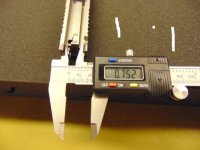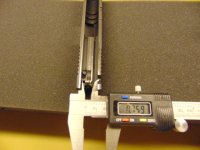redlightrich
New member
Hello all, I have purchased this slide for my Kimber, and the slide channel is a few thousandth's too small. My frame in the mating area is .07525, and this slide's measurement is .07525 ( the display changed when I moved my hand for the pix). Please note, my measuring device rounds to the closest half "tenth" so, there is the possibility of 6 tenths error. The slide does start and will go on approximately 3/4 of an inch by wiggling it before I become uncomfortable forcing it more.
Removing metal from the frame rail is not a good option for me, as I already have 2 slides that fit the frame. If I remove metal from the frame, I will be introducing unnecessary clearance with the existing slides.
Does anyone have a suggestion as to who can handle this type of machining process? I am not opposed to buying tools and working it by hand if that is possible. My guess is I need to remove approximately .001 to .0015 from each side, for a total of .003
The factory slide is fit a little on the loose side, and it measures .0759 in the same area. My second slide, which fits better ( but still not perfect) measures 0758.
Ideally, I can open this slide to .0756 or .0757
Any referral or recommendation will be greatly appreciated.
Thank you
Rich
Removing metal from the frame rail is not a good option for me, as I already have 2 slides that fit the frame. If I remove metal from the frame, I will be introducing unnecessary clearance with the existing slides.
Does anyone have a suggestion as to who can handle this type of machining process? I am not opposed to buying tools and working it by hand if that is possible. My guess is I need to remove approximately .001 to .0015 from each side, for a total of .003
The factory slide is fit a little on the loose side, and it measures .0759 in the same area. My second slide, which fits better ( but still not perfect) measures 0758.
Ideally, I can open this slide to .0756 or .0757
Any referral or recommendation will be greatly appreciated.
Thank you
Rich


